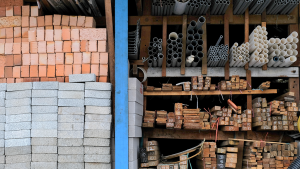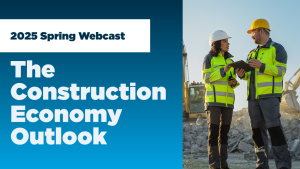In the economic headwinds buffeting Canada, the construction industry needs to have a clearly defined set of strategies to navigate the challenges it faces such as labour shortages, participants at a Buildings Show seminar were told.
Those strategies include focusing on labour training and retention programs, building a diversified client portfolio, and being acutely aware of ongoing financial turbulence in the United States and how that might impact Canadian construction firms participating in American projects.
In the United States banks have been “quietly preparing a $200-billion parachute against bad debts” on CRE (commercial real estate) projects, said ConstructConnect chief economist Michael Guckes.

“Banks are highly aware of this situation and won’t help the construction industry at their expense,” said Guckes, whose seminar was titled Navigating Financial Volatility in the Construction Industry.
The overall theme of the presentation, however, was that Canada is poised for better economic growth in 2025.
Contributing factors include falling interest rates, a growing population and resurgence in U.S. economic activity under the incoming presidency of Donald Trump.
“We see the majority of Canada’s construction sub-categories growing by 10 per cent or more next year,” said Guckes, whose PowerPoint presentation listed those categories.
Leading the list is a projected 137 per cent growth (compared to 2024) in industrial and transportation terminal construction, followed by a 112 per cent climb in motel and hotel construction and, in third place, retail construction, with a predicted 104.4 per cent climb.
But there are a number of troublesome negative indicators facing this country, he cautioned.
The United States remains Canada’s overwhelming trade partner, consuming 77 per cent of Canadian exports. Those exports amount to 20 per cent of Canada’s GDP (gross domestic product). But custom (or tariff) duties on those products could move significantly higher under Trump he warned.
Higher interest rates are also having a slowing economic effect across North America, although inflation concerns have largely subsided and that gives the Bank of Canada “breathing room” to lower rates.
Rates have been falling faster than in the United States, but that does have the effect of lowering the Canadian dollar.
Over history, Canadian and U.S. monetary policies have been very similar, said Guckes, whose presentation was somewhat of a “compare and contrast” overview of the two economies. In comparing Canadian and U.S. unemployment trends, he pointed out Canada’s unemployment rate has risen much faster over the past two years.
Underinvestment in energy projects has also kept production growth to 11 per cent compared to 24 per cent south of the border.
A bright spot is immigration, which has been the key to population growth. At the same time, that population growth has brought challenges.
Investors have crowded into the housing market, pushing up prices and challenging family ownership.
Regulatory requirements and taxes have also prevented growth in the supply of homes, even though homebuilders continue to work at an accelerated rate, he said.
“Immigration presents a significant opportunity to Canada’s overall economy and with the construction industry specifically.”
Harnessing and tapping into that employment pool is crucial, said Guckes.
“Your most important long-run business decisions may be who you pick as your human relations director,” said Guckes, pointing out that industry, in its desperation to obtain skilled labour, shouldn’t be pushing workers into positions they’re not qualified for. Nor should firms hire more workers than they can absorb.
“Accept that today’s labour challenges are structural and require firms to take a refreshed, long-run approach to one’s labour strategy. The ability to rehire former labour (that was laid off) is and will remain a greater challenge than in the past.”
The need to hire, train and retain the right employee are key strategies that will impact a construction firm’s success. The others include having their financial affairs in order, possessing an entrepreneurial zeal/strategy and mastering the “economic terrain.”
By the term terrain he was referring to factors that dictate the direction of projects such as whether they’re public or private or new construction compared to renovation undertakings.
“To some degree you can select your path through this terrain. Then through shrewd decision-making you can customize your company’s ability to travel the selected path and terrain.”





Recent Comments
comments for this post are closed